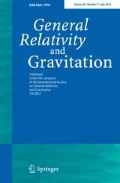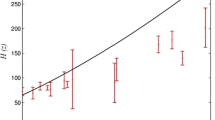Abstract
Recently, we have investigated the dynamics of the universe in tachyon cosmology with non-minimal coupling to matter (Farajollahi et al. in Mod Phys Lett A 26(15):1125–1135, 2011; Phys Lett B 711(3–4)15:225–231,2012; Phys Rev D 83:124042, 2011; JCAP 10:014, 20112011; JCAP 05:017, 2011). In particular, for the interacting holographic dark energy (IHDE), the model is studied in Farajollahi et al. (Astrophys Space Sci 336(2):461–467, 2011). In the current work, a significant observational program has been conducted to unveil the model’s thermodynamic properties. Our result shows that the IHDE version of our model better fits the observational data than \(\Lambda \)CDM model. The first and generalized second thermodynamics laws for the universe enveloped by cosmological apparent and event horizon are revisited. From the results, both first and generalized second laws, constrained by the observational data, are satisfied on cosmological apparent horizon.In addition, the total entropy is verified with the observation only if the horizon of the universe is taken as apparent horizon. Then, due to validity of generalized second law, the current cosmic acceleration is also predicted.



Similar content being viewed by others
References
Riess, A.G., et al.: Astron. J. 116, 1009 (1998)
Perlmutter, S., et al.: Astrophys. J. 517, 565 (1999)
Spergel, D.N., et al.: ApJS 148, 175 (2003)
Spergel, D.N., et al.: ApJS 170, 377S (2007)
Tegmark, M., et al.: Phys. Rev. D. 69, 103501 (2004)
Eisenstein, D.J., et al.: Astrophys. J. 633, 560 (2005)
Caldwell, R.R., Dave, R., Steinhardt, R.J.: Phys. Rev. Lett. 80, 1582 (1998)
Caldwell, R.R.: Phys. Lett. B. 545, 23 (2002)
Armendariz-Picon, C., Mukhanov, V., Steinhardt, P.J.: Phys. Rev. D. 63, 103510 (2001)
Padmanabhan, T.: Phys. Rev. D. 66, 021301 (2002)
Sen, A.: Phys. Scripta. T. 117, 70 (2005)
Feng, B., Wang, X.L., Zhang, X.M.: Phys. Lett. B. 607, 35 (2005)
Elizadle, E., Nojiri, S., Odintsov, S.D.: Phys. Rev. D. 70, 043539 (2004)
Kamenshchik, A., Moschella, U., Pasquier, V.: Phys. Lett. B. 511, 265 (2001)
Bento, M.C., Bertolami, O., Sen, A.A.: Phys. Rev. D. 66, 043507 (2002)
Cohen, A.G., Kaplan, D.B., Nelson, A.E.: Phys. Rev. Lett. 82, 4971 (1999)
Li, M.: Phys. Lett. B. 603, 1 (2004)
Wei, H., Cai, R.G.: Phys. Lett. B. 663, 1 (2008)
Wei, H., Cai, R.G.: Phys. Lett. B. 660, 113 (2008)
Gao, C., Wu, F., Chen, X., Shen, Y.G.: Phys. Rev. D. 79, 043511 (2009)
Hsu, S.D.H.: Phys. Lett. B. 594, 13 (2004)
Huang, Q.G., Li, M.: JCAP 0408, 013 (2004)
Wang, B., Gong, Y.G., Abdalla, E.: Phys. Rev. D 74, 083520 (2006)
Wang, B., Zang, J., Lin, C.Y., Abdalla, E., Micheletti, S.: Nucl. Phys. B. 778, 69–84 (2007)
Amendola, L.: Phys. Rev. D. 62, 043511 (2000)
Sandvik, H., Tegmark, M., Zaldarriaga, M., Waga, I.: Phys. Rev. D. 69, 123524 (2004)
Mohseni Sadjadi, H., Honardoost, M.: Phys. Lett. B. 647, 231 (2007)
Wu, Q., Gong, Y., Wang, A., Alcaniz, J.S.: Phys. Lett. B. 659, 34 (2008)
Brax, P., Bruck, C.V., Mota, D.F., Nunes, N.J., Winther, H.A.: Phys. Rev. D. 82, 083503 (2010)
Davis, A.C., Schelpe, C.A.O., Shaw, D.J.: Phys. Rev. D. 80, 064016 (2009)
Ito, Y., Nojiri, S.: Phys. Rev. D. 79, 103008 (2009)
Huang, W.H.: Phys. Lett. B. 561, 153 (2003)
Bagla, J.S., Jassal, H.K., Padmanabhan, T.: Phys. Rev. D. 67, 063504 (2003)
Setare, M.R.: Phys. Lett. B. 653, 116–121 (2007)
Setare, M.R.: JCAP 0701, 023 (2007)
Bardeen, J.M., Carter, B., Hawking, S.W.: Comm. Math. Phys. 31, 161 (1973)
Hawking, S.W.: Comm. Math. Phys. 43, 199 (1975)
Bekenstein, J.D.: Phys. Rev. D. 7, 2333 (1973)
Jacobson, T.: Phys. Rev. Lett. 75, 1260 (1995)
Verlinde, E.: hep-th/0008140
Padmanabhan, T.: Class. Quantum Gravit. 19, 5387 (2002)
Cai, R.G., Kim, S.P.: JHEP 02, 050 (2005)
Bhattacharya, S., Debnath, U.: Int. J. Theor. Phys. 50, 525–536 (2011)
Bamba, K., Geng, C.Q., Tsujikawa, S.: Int. J. Mod. Phys. D. 20, 1363–1371 (2011)
Zhang, Y., Gong, Y.G., Zhu, Z.H.: Int. J. Mod. Phys. D. 20(8), 1505–1519 (2011)
Bamba, K., Geng, C.Q., Tsujikawa, S.: Phys. Lett. B. 688, 101–109 (2010)
Chattopadhyay, S., Debnath, U.: Can. J. Phys. 88, 933–938 (2010)
Mazumder, N., Chakraborty, S.: Gen. Relativ. Gravit. 42, 813–820 (2010)
Setare, M.R., Vagenas, E.C.: Phys. Lett. B. 666, 111–115 (2008)
Wang, B., Lin, C.Y., Pavon, D., Abdalla, E.: Phys. Lett. B. 662, 1–6 (2008)
Cao, S., Zhu, Z.H., Liang, N.: Astrono. Astrophys. 529, A61 (2011)
Farajollahi, H., Ravanpak, A., Farrpoor Fadakar, G.: Mod. Phys. Lett. A. 26(15), 1125–1135 (2011)
Farajollahi, H., Ravanpak, A., Fadakar, G.F.: Phys. Lett. B. 711, 3–4, 15, 225–231 (2012)
Farajollahi, H., Salehi, A.: Phys. Rev. D. 83, 124042 (2011)
Farajollahi, H., Salehi, A., Shahabi, A.: JCAP 10, 014 (2011)
Farajollahi, H., Salehi, A., Tayebi, F., Ravanpak, A.: JCAP 05, 017 (2011)
Farajollahi, H., Ravanpak, A., Fadakar, G.F.: Astrophys. Space. Sci. 336(2), 461–467 (2011)
Wang, Y., Mukherjee, P.: Astrophys. J. 650, 1 (2006)
Bond, J.R., Efstathiou, G., Tegmark, M.: Mon. Not. R. Astron. Soc. 291, L33 (1997)
Komatsu, E., et al.: Astrophys. J. Suppl. 192, 18 (2011)
Reid, B.A.: Mon. Not. R. Astron. Soc. 404, 60–85 (2010)
Percival, W.J., et al.: Mon. Not. R. Astron. Soc. 401, 2148–2168 (2010)
He, J.H., Wang, B., Zhang, P.: Phys. Rev. D. 80, 063530 (2009)
Acknowledgments
This work is supported in part by Research Grant Council of University of Guilan.
Author information
Authors and Affiliations
Corresponding author
Appendix
Appendix
We constrain the parameters including the initial conditions by minimizing the \(\chi ^2\) function given as
where the sum is over the cosmological dataset. In (5.1), \(H^{th}\) and \(H^{obs}\) are the Hubble parameters obtained from the theoretical model and from observation, respectively. Also, \(\sigma _{OHD}\) is the estimated error of the \(H^{obs}\) where obtained from observation [51].
We add the CMB data in our analysis. Since the CMB shift parameter \(R\) [58, 59], contains the main information of the observations from the CMB, it is used to constrain the theoretical models by minimizing
where \(R_{obs} = 1.725\pm 0.018\) [60], is given by the WMAP7 data. Its corresponding theoretical value is defined as
with \(z_{CMB} = 1091.3\).
Moreover, for the BAO data, the BAO distance ratio at \(z = 0.20\) and \(z = 0.35\) from the joint analysis of the 2dF Galaxy Redsihft Survey and SDSS data [61–63] is used. The distance ratio, given by
is a relatively model independent quantity with \(D_V(z)\) defined as
So, the constraint from BAO can be obtained by performing the following \(\chi ^2\) statistics
The constraints from a combination of OHD, BAO and CMB can be obtained by minimizing \(\chi ^2_{OHD}+\chi ^2_{BAO}+\chi ^2_{CMB}\).
Rights and permissions
About this article
Cite this article
Farajollahi, H., Ravanpak, A. & Abolghasemi, M. Thermodynamics and holography of tachyon cosmology. Gen Relativ Gravit 45, 465–476 (2013). https://doi.org/10.1007/s10714-012-1481-x
Received:
Accepted:
Published:
Issue Date:
DOI: https://doi.org/10.1007/s10714-012-1481-x




